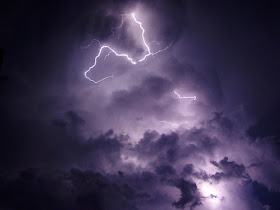So this would indicate St Ilija the Thunderer is probably the Christianized pagan god of thunder lightning and rain.
But Serbian folk tradition also says that every year St Ilija the Thunderer gets so angry that he wants to "burn the whole world down". As I already explained in my post "Two crosses", the 21st of June, the mid summer, is the day of the maximum sun light. But it is the 2nd of August the day that marks the end of summer, that is the day of maximum sun heat. And this is the day when Serbs celebrate St Ilia the Thunderer. The period three days before and the three days after the 2nd of August, is in South Slavic tradition called Kresovi meaning Fires. These are the days of wild fires and droughts. These days are also known as the dog days, because these are the days when the dog star Sirius is in the sky with the sun.
But thankfully "Ilia the thunderer" does not burn the earth. Every year, on his day, the 2nd of August, the day of St Ilija the Thunderer, he gets persuaded by his wife/sister, Ognjena Marija (Fiary Mary) to calm down. In Serbia there is a saying: "Od svetog Ilije sunce sve milije" which means "From St Ilija the sun starts getting kinder, milder, gentler". The first part of the 2nd of August is considered summer and the second is considered to be Autumn. And thus every year on the 2nd of August the summer ends and the autumn begins.
The fact that it is "Ilija the thunderer" who is accused of "wanting to burn the whole word", shows direct link between "Ilija the thunderer" and the burning late summer sun. Is it possible that Ilia the thunderer is also a Christianized sun god?
How is it possible that the same character could personify the burning sun and the storms?
Well do you remember my post "Sun, Thunder, Fire"? In it explained how modern science has proven the existence of the direct link between the solar winds and lightning. In short, without solar winds there would be no lightning.
When we compare our current knowledge of the development of thunder and lightning with the above description of the "Thundering sun god driving his chariots over the tops of the clouds with flashes of lightning sparking from the chariot wheels", we can see that this is pretty faithful description of what is actually happening during August thunderstorms.
There are two basic types of lightnings:
1. Vertical, cloud to earth (or earth to cloud)
2. Horizontal, cloud to cloud.
Belgrade school of meteorology has been conducting 35 year long research in frequency and characteristics of lightning over Serbia.
In Serbia the number of thunder and lightnings is the highest at the end of June and beginning of July, but during that time thundering is very strong and short due to the angle under which the solar wind enters the atmosphere. If there is rolling thunder it is always very short.
On the contrary, the first days of August have the largest number of rolling thunder and lightnings. This is the period of the year when solar wind arrives from the sun under the smaller angle which creates longest rolling time of the solar wind particles over the tops of the clouds. Heliocentric electromagnetic research have shown that due to high speed, particles of the solar wind bounce off the tops of the clouds in the same way a flat stone bounces of the surface of water. Every bounce causes a sound effect in the shape of thunder and a flash of lightning. During that period you can hear how the fireball consisting of the particles of the solar wind, approaches and then goes away. Based on the audio and visual data you can precisely calculate the line and direction of the rolling of the thunder wheel.
Just as if "the thundering sun god was driving his chariots over the tops of the clouds with flashes of lightning sparking from the chariot wheels"...
We know that wheel is a symbol directly linked with sun. But it is also linked with thunder and fire. We can see this through the symbols of Svetovid and Perun: their wheels. The wheel of Perun is "like" the wheel of Svetovid. It is actually the fiery version of the wheel of Svetovid. Sun creating fire through lightning.
So the fiery wheels of Perun, the Thunder god, are actually burning sun wheels of Svetovid, the Sun god. This is symbolic representation of now scientifically proven link between the sun and lightning.
And the same link between Thunder and Lightning (Perun) and Sun (Svetovid), is also represented by the character of Ilija the Thunderer, the Thundering Sun...The thundering sun god driving his chariots over the tops of the clouds with flashes of lightning sparking from the chariot wheels...




Thank you for interesting post.
ReplyDeleteIn Ukrainian volklore there is also an Ilija the Thunderer and the lightning is caled in some regions "perun" or "perunitsa". But you mean that this sun-thunder god is celtic?
It predates both Celtic and Slavic cultures...
DeleteBut these depictions of Saint Ilija in a fiery chariot come from the bible...
ReplyDeleteThat's not the point. The point is the belief South Slavs (and Greeks) attached to this strange "saint", who btw is believed to have been just thinly disguised sky god himself...Check this out https://www.jstor.org/stable/27908938?read-now=1&refreqid=excelsior%3Aaa6250d98d6365fefa3c98a57872f1da&seq=6#page_scan_tab_contents
Deletehttps://en.wikipedia.org/wiki/Elijah#Elijah_in_Jewish_folklore